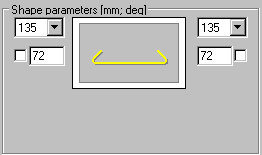This option is used to define a straight bar. Access this option by clicking ![]() . The following dialog displays:
. The following dialog displays:

To define a bar, specify the following from the dialog:
- Bar diameter (the most recent diameter for this reinforcement type is adopted by default)
- Cover of a reinforcing bar (the most recent cover defined for this reinforcement type is adopted by default)
- In the Parameters of reinforcing bar shape field - parameters of bar ending with hooks, i.e., a hook angle and length (the hook length defined in the dialog denotes a length of the straight segment of a hook or its real length - see Options in the Job Preferences dialog). You can lock a hook length by selecting the option next to the edit field for defining a hook length (
 appears); the edit field becomes inaccessible. If you modify parameters (length or diameter) of a bar with locked hook length, the hook length does not change.
appears); the edit field becomes inaccessible. If you modify parameters (length or diameter) of a bar with locked hook length, the hook length does not change.
The list of standard hook angle values: (see: method of measuring the angle of bar bending):
- 0º
- 90º
- 135º
- 180º
- -90º
- -135º
- -180º.
When defining the straight bar, only ![]() (2 Points) is available (the remaining icons are unavailable); indicate the two bar points, and click to start the definition.
(2 Points) is available (the remaining icons are unavailable); indicate the two bar points, and click to start the definition.
Note: Bar location depends on the direction of point definition. The principle that applies while defining a reinforcing bar includes determining the order of points clockwise (along the EXTERNAL part of an object).The defined bar will always be positioned in the inner part of an object. In the case of bar with hooks with a bending angle greater than zero degrees, the hooks will always be positioned on the side opposite to the side where points defining the bar length are placed, thus they will be turned towards the middle of an object.
After defining the first point determining the bar position, the bar length changes depending on the cursor position.
See also:
Commands from the command line - definition of longitudinal reinforcement